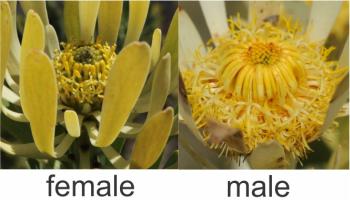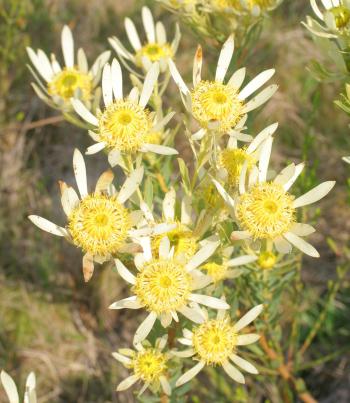Leucadendron chamelaea
Leucadendron chamelaea (Lam.) I.Williams
Family: Proteaceae
Common names: Witsenberg conebush
Introduction
Leucadendron chamelaea is one of the iconic species of the Upper Breede River Valley. This species once occurred commonly in this area, but through the intensification of agricultural practices, it has suffered severe population reduction and is now on the brink of extinction in the wild.

Description
Description
Erect shrub, up to 2.5 m tall. Branches are terete, glabrous, with long linear-oblanceolate glabrous leaves. Apex of leaves acute with a small blunt mucro. The involucral leaves in male plants are up to 45 mm long and 5 mm wide, not concealing the flowerhead, but exceeding it. Involucral bracts in female plants are up to 68 mm long and 6 mm wide. They form a cup exceeding the cones, but not concealing it. Male flowerheads are up to 20 mm in diameter, depressed globose, solitary at the end of branches. Female inflorescences are 17 mm long and 21 mm in diameter. The flowerheads are strongly scented and are produced in spring (Sept. to Oct.).

Conservation Status
Status
Leucadendron chamelaea is Critically Endangered (CR). A past population reduction of at least 60% is estimated, based on 55% habitat loss because of agriculture and the local extinction of 52% of subpopulations known through herbarium records. Remaining subpopulations are fragmented and largely confined to road verges and adjacent areas.
Population reduction was previously underestimated (at 55% occupancy) and has been escalating. In 2004, an estimated 33% of remaining subpopulations were cleared as part of road verge maintenance programmes and agricultural pest control, in particular control of “Vaalwurm”. Road verge clearing continues to cause decline, and population reduction is likely to exceed 80% within the next 20 years (generation length 20 years). A few other subpopulations remain on small isolated pockets between agricultural fields, where they are also declining as a result of a lack of fire, expanding agriculture, in particular the cultivation of fruit orchards, vineyards, potato and cash crops, wetland drainage, alien plant invasion, browsing and overgrazing. Unless the practice of clearing road reserves ceases soon, this species will be confined to a very few remnant patches. Only a single isolated subpopulation of less than 100 plants in the Groot Winterhoek is currently conserved.
This species is also an indicator of special habitat, and wherever there are populations of this species, the CREW team has found numerous other threatened plants at these sites.

Distribution and habitat
Distribution description
This species is distributed through the Koue Bokkeveld to Franschhoek Valley in the Western Cape, it is found on sandstone flats in Breede Alluvium Fynbos.
Derivation of name and historical aspects
History
Leucadendron means ‘white tree’. The species name chamelaea, is derived from the Greek word chamae, which means ‘low, or on the ground’, referring to a creeping habit. The species was first described by Lamarck from a collection made by Sonnerat. The collection was in fact a mixture of two species being L. chamelaea and L. lanigerum var. laevigatum. These species occur together in the Wolseley area. Because there was only a small male twig of L. chamelaea, this could be the explanation of the odd name given to this species. The habit of the plant is in fact a tall upright shrub and not a low-growing creeper, as the name suggests. Who said it was easy to describe a species from a small dried up twig?
Ecology
Ecology
This species grows in sandy flats and has rather large flowerheads. It is a single-stemmed species, so is killed by fire and regenerates from seeds. The seeds are held in the cones, but the cones are not tightly closed, so once the seeds are ripe, they can fall to ground out of the cones if they are knocked or blown by a strong wind. Plants flower in spring (September to October), are strongly scented and are pollinated by insects. Seeds ripen within two months.

Uses
Use
There are no recorded cultural or medicinal uses for this plant, but it has good horticultural potential. It has potential as a great cutflower species because of its huge flower heads, symmetrical cones, and it has very long straight stems.
Growing Leucadendron chamelaea
Grow
Leucadendron chamelaea belongs in the Crown Conebush group, with L. elimense (Elim Conebush) and L. globosum (Grabouw Conebush), and the same method can be followed for propagation of most Leucadendron species.
Although this species can be propagated by seeds or cuttings, it is highly recommended to use seeds. Seeds are sown in autumn in seed trays with a 50/50 bark and river sand mix. Soil must have good drainage properties otherwise seeds will rot. Seeds will germinate in three to four weeks, and once the seedlings have true leaves, they can be planted in small bags. Place in a semi-shady position for plants to harden off and grow. After one year they can be planted in the garden.
Semi-hardwood cuttings can be taken in late summer to autumn. Cutting must be dusted with hormone powder/liquid and planted in seed trays. Once roots start developing they can be transplanted to small bags.
References
- Goldblatt, P. & Manning, J. 2000. Cape Plants. A conspectus of the Cape flora of South Africa. Strelitzia 9. National Botanical Institute, Pretoria & Missouri Botanical Garden, Missouri.
- Raimondo, D. et al. 2009. Red list of South African plants. Strelitzia 25. SANBI (South African National Biodiversity Institute), Pretoria.
- Rebelo, A.G. 2001. Proteas. A field guide to the proteas of southern Africa, edn 2. Fernwood Press, Vlaeberg, Cape Town.
- Rebelo, A.G., et al. 2011. Leucadendron chamelaea (Lam.) I.Williams. National Assessment: Red List of South African plants version 2015.1. Accessed on 2016/02/01.
- Vogts, M. 1982. South African's Proteaceae: know them and grow them. Struik, Cape Town.
- Williams, I.J.M. 1972. A revision of the genus Leucadendron (Proteaceae). Contributions from the Bolus Herbarium 3. University of Cape Town.
- iSpot southern Africa http://www.ispotnature.org/search/node/Leucadendron%20chamelaea
Credits
Ismail Ebrahim
Custodians of Rare and Endangered Wildflowers (CREW)
February 2016
Plant Attributes:
Plant Type: Shrub
SA Distribution: Western Cape
Soil type: Sandy
Flowering season: Spring
PH: Acid
Flower colour: Yellow
Aspect: Full Sun
Gardening skill: Average
Special Features:
Horticultural zones








Rate this article
Article well written and informative
Rate this plant
Is this an interesting plant?
Login to add your Comment
Back to topNot registered yet? Click here to register.